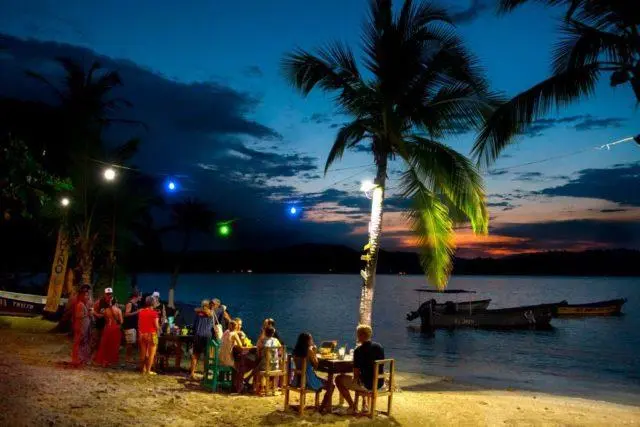by Herb DeMars

Thinking about relocating – Paradise Awaits You!
By The Costa Rica Star – May 28, 2020
By Laura Gutierrez of Immigration Help Costa Rica
The Pandemic situation has some of you intrepid types thinking about a more tranquil, warm, and safe country in which to live. As one who once immigrated abroad with a toddler in tow, I understand the burning need for realistic and meaningful information. Hopefully, this will help you move beyond dreams into action.
Costa Rica boasts a very low per capita COVID infection/mortality rate compared to other countries and regions around the globe. It is getting a great deal of positive attention as a result. These remarkable health outcomes are rooted in the combination of some very unique elements.
Costa Rica sits between two oceans with refreshing wind currents. It has some of the best year-round climates anywhere with no violent extremes. It also has a widely varying topography with mountains, high plains, and low lying coastal plains well-marbled with 14 major river systems. Its administrative structures are modeled on Switzerland (Cantons). That system facilitates evenly distributed social and commercial structures and country-wide initiatives when it comes to the education, health, and welfare of the populace. Costa Rica is a democracy with a legislature and senate headed up by a democratically elected president. There is no standing army which allows for more resources to be invested in health and education. Much in contrast to our neighbors.
While many of the states such as New York suffered through this pandemic in highly restrictive indoor environments in the gloom of late winter, those here bathed in warm breezes under immune-boosting sunshine on bare skin. (Vitamin D3.) That is mid-summer for Costa Rica. Warm and dry. From May to November, the rains green things up, but most days, we still get a good dose of sunshine and a fresh breeze. Most of us don’t need A/C, heaters or screens on our windows.
There is a lot of well-founded speculation about an impending round of hyperinflation fueled by $6 trillion recently being added to the U.S. debt. Leading economists all agree that access to affordable food will be a top priority. (Average food costs in the U.S. have already jumped up 15%.) It’s of primal consideration. Costa Rica’s meters-deep, mineral-rich volcanic soils, and its tropical and sub-tropical weather give it the ability to produce fresh, field ripened produce year-round. Nutrition at its best. No winters. No long haul transportation, lengthy storage or shelf life costs to factor in. This is also a crucial immune-boosting consideration.
So if that has whet your appetite enough to trigger serious plans to immigrate, here are FIVE crucial steps to consider.
1) If you have not been yet or only spent one or two vacations here that left a very appealing impression, then return for a more sustained length of time — at least one or two months. Travel around and explore. Costa Rica has 12 distinct mini climates and 110 soil types. The combination of those make for a wide variety of environments, each with a unique feel to appeal to specific personality types. Some people love the beach, some the mountains, while others must live close to modern conveniences found in abundance in the Central Valley from San Ramon, Grecia, Atenas to Santa Ana and Escazu. Those areas have the best year-round weather on the planet. Perez Zeledon, Dominical and Uvita are also popular venues in the southern zones. Highly unique Lake Arenal is also worth a visit after you travel up the Pacific coast from Jaco, Samara, Tamarindo to Playa Coco and Hermosa.
The sorting out process involves meticulous gathering of facts combined with your intuition. It’s a big move. The best place to start is a disciplined search on the internet. I would also suggest downloading Google Earth Pro. This handy app will allow you to “fly” around all of Costa Rica on your computer well before your next visit. Utilize this fantastic FREE technology to plan your routes of exploration. When you arrive and explore in person, ask a lot of questions of ex-pats who have lived here two to three years or more.
2 )If you decide Costa Rica is definitely for you, it will be prudent to first attend to administrative considerations. Update your wills, and visit with your CPA to get up to speed on tax implications of non-residency. Get all your financials in order. What will you live on? A pension? Investments? Please don’t count on a job in Costa Rica unless it is something online. You are not allowed to work here for at least the first three years of legal residency. You are entitled to own a business and draw dividends.
3) For many, divesting of your home will likely provide the funds to finance your move and life here. Garage sales and selling homes are big, stressful jobs. Don’t try to transition to Costa Rica while simultaneously divesting of your goods back home. One thing at a time. Leave as much of your STUFF behind. Downsize by 90%! And forget clothes made of synthetic materials. It’s hot down here. Cotton only. Also, sell your vehicles and re-purchase something suitable here. AWD usually a must, especially in the Boonies. It’s a huge hassle to bring vehicles where punitive import taxes await you as well as in-transit damage and theft. Consult ex-pats about whom to trust for vehicle purchase and servicing here. Asian brands are the most ubiquitous — American the least.
4) Purchase healthcare insurance. You will need it for a least the first two years of living here.
5) Pursue legal residency. Ignore barstool nihilists and “advisors” who scoff at the idea. This is no time of your life nor a place where you want to live like a refugee. (Perpetual Tourist) Legal residency results in an undeniably enhanced lived experience here in Costa Rica. Part of the requirement is enrollment in CAJA, Costa Rica’s universal healthcare plan similar in structure to Canada and the U.K. that delivers world-class care, doctors, and affordable medicine. The downsides are wait times and some less than stellar facilities in some communities. Costa Rica also allows the purchase of private healthcare and has plenty to offer. But CAJA is mandatory. From the time you begin the residency process to the day you have your residency cards in hand can take up to two years—ergo the need for private health insurance to cover you and yours over that period. The process can be started from your originating country or from here in Costa Rica with proper guidance. Lots of details to take into account.
These are the most general and essential steps to consider. Other considerations are real estate, banking, security, schools, driver licenses, entry/exit rules, wills, taxes, etc. For most of you, none of those will be deal-breakers. 100,000 permanent U.S., 10,000 Canadian, and many other ex-pats from around the globe have already blazed the trail before you
If your in need of immigration assistance Laura can be reached by clicking here, Toll free at 1-833-733-6337, Locally at or by sending a email to laura@immigrationhelpcr.com.

